Are Ankle Compression Socks Good for Shin Splin
Compression socks don't just look pro as heck—they also boast post-race performance and recovery benefits. Aside from the sensation of your legs being drawn into a cozy, supportive hug—almost like a weighted blanket for your active muscles—the compression can actually improve blood flow and energize your legs. Some socks are designed to be worn during running, others are for the hours and even days after your big event, and still others are for medical uses beyond sport, like battling edema and Deep Vein Thrombosis (we recommend sticking to the running-specific models, unless you've been diagnosed with these). Beyond that, there's a world of choice between different socks and how much compression they offer, what kind of performance fabrics are used, antimicrobial and wicking properties, breathability, and cushioning. Here are a few other things to keep in mind when you're shopping for compression socks.
Do Compression Socks Actually Work?
Over the years, a number of clinical studies have been conducted to determine whether compression socks and clothing have an effect on running performance and recovery, as sock-makers have claimed. For the most part, these studies have concluded that the socks don't have a significant influence on run performance, though there might be some placebo-effect improvements. In other words, if you think they'll improve your running, they might, in fact, actually improve your running.
Where compression gear does show significant benefit is with regard to recovery. One study from 2015 in the Journal of Strength and Conditioning Research found that wearing compression socks for 48 hours after a marathon improved performance by 2.6 percent on a treadmill test two weeks later—indicating that the runners wearing the socks had recovered faster. Other studies agree compression socks can reduce muscle pain, damage, and inflammation by improving your blood flow. Of course, pregnant women, nurses, and other people who stand all day could have told you that—many wear compression socks to ease the swelling in their feet and keep their legs from getting tired and achy.
How Does Gradient Compression Work?
Compression socks that boast "gradient compression" qualities apply a controlled amount of pressure at the ankle that gradually decreases up the leg, as opposed to a steady level of compression throughout. This has the effect of pushing blood flow and circulation up the leg and preventing swelling at the ankle. If your compression socks are so tight they're digging into your skin and causing discomfort, size up—the feeling should be one of having your legs supported, not constricted.
How Is Compression Measured?
Because compression socks are considered medical-grade devices, standardized pressure levels can be measured on an mmHg scale, or "millimeters of Mercury." The scale is as follows: Mild (8–15 mmHg), Medium (15–20 mmHg), Firm (20–30 mmHg), Extra Firm (30–40 mmHg), and RX (40–50 mmHg). Most running compression socks fall into the mild to firm range; the RX range is reserved for serious medical problems, like blood clots. Some compression sock brands don't share their mmHg numbers, as outside factors like how the sock fits can cause the number to vary a bit. Some studies have shown 20 mmHg to be the ideal amount of pressure for at-rest recovery, though you might want to experiment to find out what's most comfortable for you. The numbers listed should give you a rough idea.
When Do I Wear Compression Socks?
While many runners wear their socks or sleeves for post-workout recovery, you can reap the benefits from compression gear at any time. Some athletes train and even race in compression socks to help encourage blood flow through the lower leg and calves. (However, most will opt for a lighter grade of compression if they are using the sleeves during exercising.) And if you're traveling for your next big race, shimmying into a pair of squeeze-y socks can alleviate leg cramps during long cars rides and flights.
OK, Now How Do I Get Them On?
The one issue with compression gear is that it can be a workout in itself to put on. However, a few tricks and the right technique can make wriggling into your socks or sleeves quick and easy. Check out the video below from our Runner-in-Chief and Gear Editor, Jeff Dengate, for the best strategy for donning tight compression gear.
How We Selected
Every product here has been thoroughly evaluated and vetted by our team of test editors. We research the market, survey user reviews, speak with product managers, and use our own experience running in these compression socks to determine the best options. Most models have been tested by our staff, and those that haven't have been carefully chosen based on their value, technical fabrics, comfort, looks, and ability to wick away sweat and improve recovery. Here are the best compression socks we've found.
Zensah Compression Leg Sleeves

These leg sleeves give you all the benefits of compression socks without the strain of wrangling your foot in and out of them—or robbing you of the chance to race in your lucky socks. Designed to imitate leg-taping methods used to combat shin splints, Zensah's leg sleeves hug your calves and help your muscles recover more quickly. And for those of us who spend half of our long runs fantasizing about what to eat for the rest of the day, the sleeves come in fun food prints, like Donut and Watermelon.
Sigvaris Performance Compression Running Sleeve

Performance Compression Running Sleeve
Covering only your calf, these nylon-spandex sleeves are a little easier to pull on than full socks despite a snug 20 to 30 mmHG compression level. They'll work for any sport, but triathletes (and water polo players) will appreciate the compression sleeves' ability to take a dunk in chlorine or salt water without deteriorating.
Feetures Graduated Compression Socks
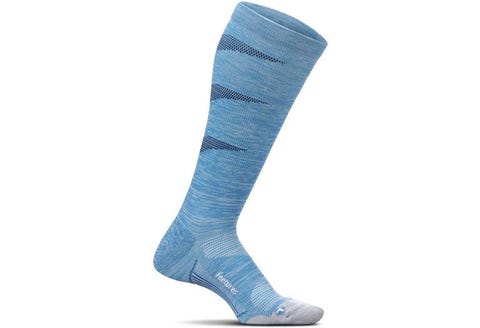
Graduated Compression Knee High Socks
Feetures amazon.com
The good: Feetures makes its socks from a soft, moisture-wicking fabric that perfectly conforms to your foot, thanks to an anatomical design with a designated "right" and "left" sock. The bad: Somehow my dryer has developed a taste for only "right" Feetures. Aside from that small complaint, we love that these socks have 15 to 20 mmHg of compression to help your circulation, while keeping your feet all-day cozy and blister-free.
Run Forever Sports Calf Compression Sleeves
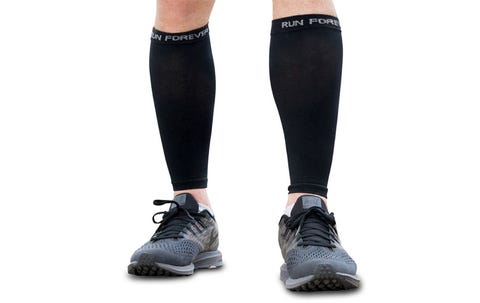
Calf Compression Sleeves
Run Forever Sports amazon.com
A solid budget option, Run Forever compression sleeves strike a nice balance between performance and cost. Made of a stretchy and breathable nylon-spandex blend, the calf sleeves have a firm 20 to 25 mmHg graduated compression rating and a stay-up cuff to hold them in place so they won't start rolling down while you run. The sleeves are available in four sizes, so you can get a snug fit that doesn't feel oppressively tight, and in lots of color and pattern options.
Darn Tough Vertex OTC Ultra-Light Socks

Darn Tough Vermont Vertex OTC Ultra-Light Sock
Darn Tough Vermont zappos.com
$34.95
For light compression that feels all-day cozy, these merino-blend socks will be the first thing you pull out of the dryer on laundry day. The socks have just enough graduated compression (11 to 16 mmHg) to feel like they're supporting your muscles without squeezing. Wear them year-round—they're designed to wick sweat and stay cool in the summer, and maintain warmth in the winter.
Swiftwick Aspire Twelve
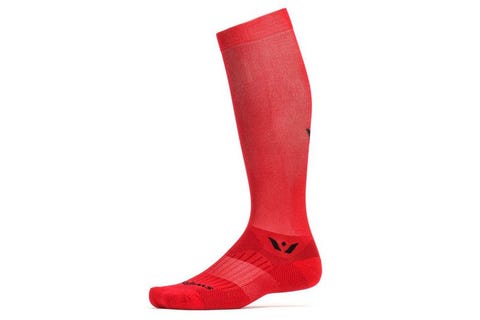
Swiftwick's Aspire socks come in five heights, all of which pull off the rare hat trick of being lightweight, ultra-durable, and all-day comfortable. The 12 is the tallest of the line, with a calf-length fit that hugs your lower legs in smooth, breathable olefin-nylon-spandex fabric. A "firm" level of gradient compression (20 to 30 mmHG) provides a snug feel to support your muscles without throttling them.
2xU Recovery Compression Socks

2XU Recovery Compression Socks
Designed to be worn after a hard workout or your next marathon, these lightweight compression socks are finely woven yet breathable, thanks to added venting panels that also prevent your foot from overheating. The sock is padded with arch support for all-day comfort when the foot is at rest; for a 2xU compression sock padded for motion, check out the brand's Performance Run Sock.
Physix Gear Sport Compression Socks
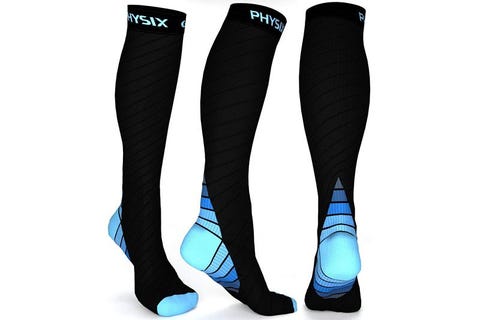
For the money, it's hard to find a better-performing pair of compression socks than these smooth Lycra numbers. Built with a 20 to 30mmHG gradient compression, they squeeze your calves snugly enough to wear under pants on those days when you're constantly on your feet. But they're also light and breathable enough to wear on summer runs, and won't slip down or budge while you're in motion.
Sockwell Circulator Compression Socks
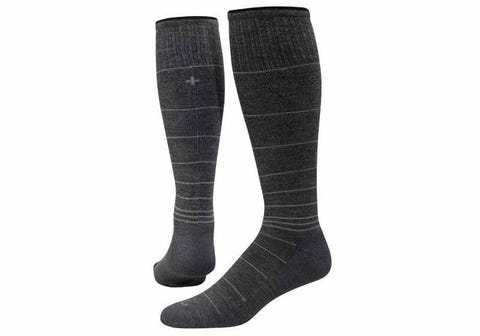
Circulator Compression Socks
If you're looking for a cozier pair of winter compression socks for running, cycling, hiking, or just lounging around by a fire in full recovery mode, these Sockwell socks are a merino wool–blend dream. Despite passing easily as any other pair of casual socks, Sockwell's Circulators have a 15 to 20 mmHg moderate graduated compression level for a supportive squeeze that's never pinching. Added cushion through the arch and soles gives your feet a little love and support.
2XU Vectr Compression Socks
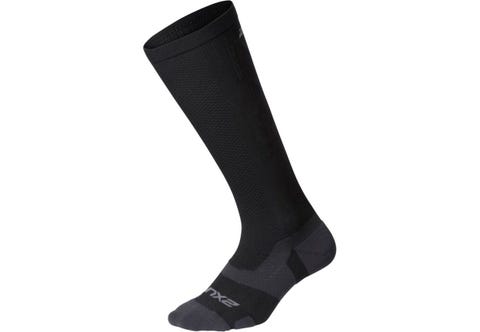
Vectr Full-Length Compression Sock
There are a lot of size options for these 20 to 30 mmHG compression socks, which gives you a better chance of getting a super-snug fit you can still wrestle off your foot. Made of a lightweight but durable nylon blend, the Vectr is destined to replace your lucky race-day socks, sheerly through the power of its compressive comfort. Added cushion in just the right places protects your feet without bunching, creating blisters, or overcrowding your shoe.
OS1st CS6 Performance Calf Sleeves

It's easy to feel like a superhero when you're having a particularly good run and that floaty, endorphin-fueled runner's high kicks in. Dress the part in these Wonder Woman–themed compression calf sleeves. Not only do they reduce muscle vibration and provide added support, but they also look badass on race day.
CEP Ultralight Socks
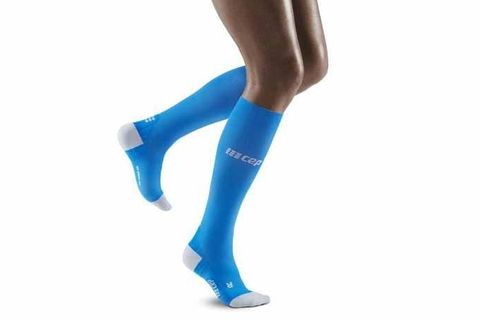
Ultralight Compression Socks
CEP cepcompression.com
$59.95
Ideal for the summer heat, these socks have 20 to 30 mmHg graduated compression packed into a lightweight nylon-spandex design that resists moisture. The socks have a seamless, reinforced toe and heel for protection from blisters; a combination of vents and sweat-wicking materials helps allow for a little airflow.
Runderwear Compression Socks

Compression Socks
Runderwear runderwear.com
$45.00
Best known for its titular running underwear—designed to combat the (arguably) worst kind of chafing—Runderwear now also makes running-specific compression socks. The socks use graduated compression that starts at a very precise 28.4 mmHg at the ankle and eases to 18.1 mmHg at the top of the sock, with the intention of reversing blood flow for better circulation. A moisture-wicking cotton-poly fabric blend keeps your calves comfortable and well-ventilated.
Lily Trotters Signature Compression Sock

Athletic Compression Socks
Lily Trotters amazon.com
With 15 to 20 mmHG of graduated compression, Lily Trotters provide just enough support and squeeze to encourage blood flow, along with a cozy, knee-length fit. The overall effect of the sock is snug—but its thinly woven nylon-spandex fabric doesn't feel restrictive like a sausage casing, nor does it feel bulky inside the toes of your running shoes or under added layers in the winter. We liked them so much we gave them a 2020 Gear of the Year award, largely due to those performance and comfort traits, plus versatility—they come in cute patterns like polka dots and holiday prints that work perfectly for a themed 5K, or solid colors for wearing casually under work clothes.
Oiselle Tall Bird Compression Socks

Tall Bird Compression Socks
If you demand style along with your compression-sock substance, these socks from Pro Compression and Oiselle are here to support you in all senses of the word. Patterned with the latter brand's signature bird flock, the Tall Bird socks have a light graduated compression to coax blood flow from your calves, plus added padding at the heel and toe. They're comfortable, durable, functional, and everything else we've grown to expect from Oiselle's apparel.
This content is created and maintained by a third party, and imported onto this page to help users provide their email addresses. You may be able to find more information about this and similar content at piano.io
Are Ankle Compression Socks Good for Shin Splin
Source: https://www.runnersworld.com/gear/a20863096/best-compression-socks/
0 Response to "Are Ankle Compression Socks Good for Shin Splin"
Post a Comment